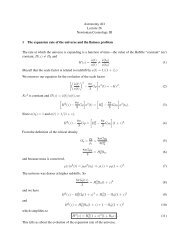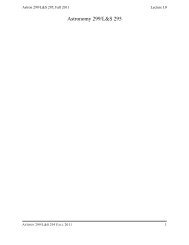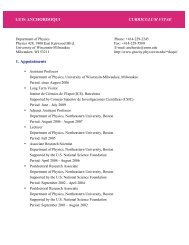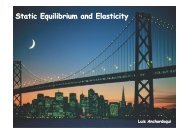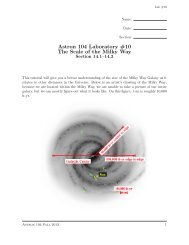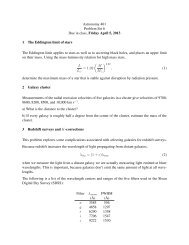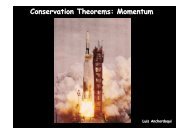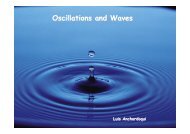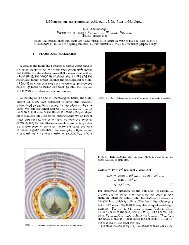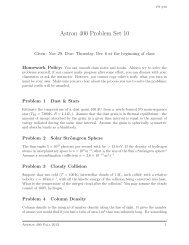Non-Euclidean geometry and the Robertson-Walker metric
Non-Euclidean geometry and the Robertson-Walker metric
Non-Euclidean geometry and the Robertson-Walker metric
You also want an ePaper? Increase the reach of your titles
YUMPU automatically turns print PDFs into web optimized ePapers that Google loves.
• On a flat <strong>Euclidean</strong> plane, a circle has circumference C = 2πr.<br />
• On a sphere of radius R, <strong>the</strong> radius of <strong>the</strong> circle r = Rθ, but <strong>the</strong> circumference is<br />
C = 2π(R sin θ) (1)<br />
( ) sin θ<br />
= 2πr<br />
(2)<br />
θ<br />
< 2πr (3)<br />
So, an observer on <strong>the</strong> surface of a sphere could measure <strong>the</strong> radius <strong>and</strong> circumference of a circle, <strong>and</strong><br />
deduce that <strong>the</strong>y were living in a positively curved world.<br />
R sin θ<br />
r<br />
θ<br />
R<br />
Figure 2: A circle on <strong>the</strong> surface of a sphere.<br />
• Similarly, in a negatively curved space, C > 2πr.<br />
2 Measuring distances <strong>and</strong> <strong>the</strong> <strong>Robertson</strong>-<strong>Walker</strong> <strong>metric</strong><br />
These differences in “big” distances must reflect differences in <strong>the</strong> infinitesimal distances from which <strong>the</strong>y<br />
are made up:<br />
∫<br />
L = dl (4)<br />
In <strong>Euclidean</strong> space, <strong>the</strong> distance between two points is<br />
L 2 = x 2 + y 2 (5)<br />
or equivalently in polar coordinates,<br />
We express infinitesimal separations similarly:<br />
L 2 = r 2 . (6)<br />
(dl) 2 = (dx) 2 + (dy) 2 (7)<br />
2





